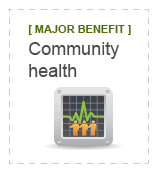Implement an environmentally sound management program for decentralized wastewater treatment systems.
Steven Oscarson, Environmental Specialist, MN Pollution Control Agency: 507-206-2604, steven.oscarson@state.mn.us, https://www.pca.state.mn.us/business-with-us/septic-systems


- Data from a well-managed set of 1545 septic systems in the Otter Tail Water Management District, formed in 1984, shows very little impact on groundwater, and improved water quality in the lakes. Total system failure rates have been less than 2%.
- Benefits of well-managed septic systems include:
- Protection of public health and local water and groundwater resources.
- Lower costs to taxpayers by keeping water potable for human consumption rather than treating contaminated water.
- Longer system life, improved system performance and increased reliability.
- Reduced costs for repairs, maintenance and replacement.
- Improved property values.
- A barrier to resale of property removed.
Minnesota Rules provide the state framework for regulation of onsite wastewater treatment. Counties have updated their ordinances to meet this rule, which was adopted in 2008. Cities that choose to regulate onsite wastewater treatment must be at least as stringent as their county's ordinance.
Optional Best Practice for Step 3 Recognition
Category A, B and C cities: implement this best practice by completing any one action.
Throughout Minnesota, failing septic systems in smaller towns and rural areas have relatively direct connections to surface and ground waters. These connections can cause detrimental impacts on the environment and can create an imminent threat to public health and safety. Standard septic systems with drainfields can also hinder cost-effective tax-base growth in small towns by preventing denser development. Cities can help structure assistance to septic owners, allowing them to implement best management practices around septic systems and to access financial programs for upgrades.
